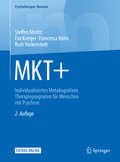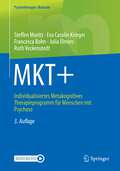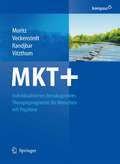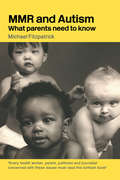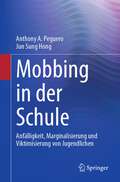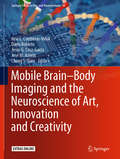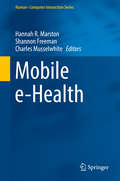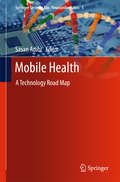- Table View
- List View
Mixed Methods In Health Sciences Research: A Practical Primer (Mixed Method Research Ser. #1)
by Leslie A. Curry Marcella Nunez-SmithMixed Methods Research for Nursing and the Health Sciences
by Sharon Andrew Elizabeth J. HalcombMixed methods research combines quantitative and qualitative research methods in a single study. The use of mixed methods research is increasingly popular in nursing and health sciences research. This growth in popularity has been driven by the increasing complexity of research problems relating to human health and wellbeing. Mixed Method Research for Nursing and the Health Sciences is an accessible, practical guide to the design, conduct and reporting of mixed method research in nursing or the health sciences. Each chapter stands alone, describing the various steps of the research process, but contains links to other chapters. Within the text, ‘real-life’ examples from the published literature, doctoral theses and the unpublished work of the authors, illustrate the concepts being discussed. Places mixed methods research within its contemporary context Includes international contributions from UK, Australia, NZ and USA Provides an accessible introduction to theoretical and philosophical underpinnings Demystifies strategies for analysing mixed methods data Examines strategies for publishing mixed methods research Includes learning objectives and exemplars in each chapter Final chapters provide ‘real-life’ examples of applied research About the Authors: Sharon Andrew is Head of Program (Postgraduate) and Elizabeth J. Halcomb is Senior Lecturer, School of Nursing & Midwifery, University of Western Sydney. Also of Interest: The Research Process in Nursing (Fifth Edition) Edited by Kate Gerrish and Anne Lacey 978-14051-3013-4 Research Handbook for Healthcare Professionals Mary Hickson 978-14051-7737-5 Real World Research: A Resource for Social Scientists and Practitioner-Researchers Second edition Colin Robson 978-0631-21305-5 Reviewing Research Evidence for Nursing Practice: Systematic Reviews Edited by Christine Webb and Brenda Roe 978-14051-4423-0
Mixed-Mode Chromatography: Principles, Methods, and Applications
by Qian-Hong WanThe book is about the technology and application of Mixed-mode chromatography (MMC). Unlike conventional single-mode HPLC, which resolves the analytes primarily based on their ionic or hydrophobic properties, MMC employs multifunctional stationary phases to exploit at least two modes of interactions (i.e., ionic and hydrophobic) with the analytes and as such often provides resolution that far exceeds that observed with a single-mode process. Over the past two decades, MMC has developed into an important analytical and purification tool in a number of applications in pharmaceutical and biotechnology industries. The technique has been used widely for the analyses of nucleic acids, amino acids, peptides, proteins, glycoproteins, carbohydrates, antibiotics, vaccines, and other products. The purpose of this book is to present a comprehensive survey of mixed-mode chromatography and is intended as a reference guide for graduate students and experienced scientists in pharmaceutical and biotechnology disciplines wishing to gain a deep understanding of this continuously evolving technology.
Mixed Models: Theory and Applications with R (Wiley Series in Probability and Statistics #893)
by Eugene DemidenkoPraise for the First Edition “This book will serve to greatly complement the growing number of texts dealing with mixed models, and I highly recommend including it in one’s personal library.” —Journal of the American Statistical Association Mixed modeling is a crucial area of statistics, enabling the analysis of clustered and longitudinal data. Mixed Models: Theory and Applications with R, Second Edition fills a gap in existing literature between mathematical and applied statistical books by presenting a powerful examination of mixed model theory and application with special attention given to the implementation in R. The new edition provides in-depth mathematical coverage of mixed models’ statistical properties and numerical algorithms, as well as nontraditional applications, such as regrowth curves, shapes, and images. The book features the latest topics in statistics including modeling of complex clustered or longitudinal data, modeling data with multiple sources of variation, modeling biological variety and heterogeneity, Healthy Akaike Information Criterion (HAIC), parameter multidimensionality, and statistics of image processing. Mixed Models: Theory and Applications with R, Second Edition features unique applications of mixed model methodology, as well as: Comprehensive theoretical discussions illustrated by examples and figures Over 300 exercises, end-of-section problems, updated data sets, and R subroutines Problems and extended projects requiring simulations in R intended to reinforce material Summaries of major results and general points of discussion at the end of each chapter Open problems in mixed modeling methodology, which can be used as the basis for research or PhD dissertations Ideal for graduate-level courses in mixed statistical modeling, the book is also an excellent reference for professionals in a range of fields, including cancer research, computer science, and engineering.
Mixed Models: Theory and Applications with R (Wiley Series in Probability and Statistics)
by Eugene DemidenkoPraise for the First Edition “This book will serve to greatly complement the growing number of texts dealing with mixed models, and I highly recommend including it in one’s personal library.” —Journal of the American Statistical Association Mixed modeling is a crucial area of statistics, enabling the analysis of clustered and longitudinal data. Mixed Models: Theory and Applications with R, Second Edition fills a gap in existing literature between mathematical and applied statistical books by presenting a powerful examination of mixed model theory and application with special attention given to the implementation in R. The new edition provides in-depth mathematical coverage of mixed models’ statistical properties and numerical algorithms, as well as nontraditional applications, such as regrowth curves, shapes, and images. The book features the latest topics in statistics including modeling of complex clustered or longitudinal data, modeling data with multiple sources of variation, modeling biological variety and heterogeneity, Healthy Akaike Information Criterion (HAIC), parameter multidimensionality, and statistics of image processing. Mixed Models: Theory and Applications with R, Second Edition features unique applications of mixed model methodology, as well as: Comprehensive theoretical discussions illustrated by examples and figures Over 300 exercises, end-of-section problems, updated data sets, and R subroutines Problems and extended projects requiring simulations in R intended to reinforce material Summaries of major results and general points of discussion at the end of each chapter Open problems in mixed modeling methodology, which can be used as the basis for research or PhD dissertations Ideal for graduate-level courses in mixed statistical modeling, the book is also an excellent reference for professionals in a range of fields, including cancer research, computer science, and engineering.
Mixture and Hidden Markov Models with R (Use R!)
by Ingmar Visser Maarten SpeekenbrinkThis book discusses mixture and hidden Markov models for modeling behavioral data. Mixture and hidden Markov models are statistical models which are useful when an observed system occupies a number of distinct “regimes” or unobserved (hidden) states. These models are widely used in a variety of fields, including artificial intelligence, biology, finance, and psychology. Hidden Markov models can be viewed as an extension of mixture models, to model transitions between states over time. Covering both mixture and hidden Markov models in a single book allows main concepts and issues to be introduced in the relatively simpler context of mixture models. After a thorough treatment of the theory and practice of mixture modeling, the conceptual leap towards hidden Markov models is relatively straightforward. This book provides many practical examples illustrating the wide variety of uses of the models. These examples are drawn from our own work in psychology, as well as other areas such as financial time series and climate data. Most examples illustrate the use of the authors’ depmixS4 package, which provides a flexible framework to construct and estimate mixture and hidden Markov models. All examples are fully reproducible and the accompanying hmmR package provides all the datasets used, as well as additional functionality. This book is suitable for advanced students and researchers with an applied background.
MKT+: Individualisiertes Metakognitives Therapieprogramm für Menschen mit Psychose (Psychotherapie: Manuale)
by Steffen Moritz Eva Krieger Francesca Bohn Ruth VeckenstedtMit dem MKT+ wird ein Therapiekonzept vorgelegt, das bewährte Techniken der kognitiven Verhaltenstherapie bei Psychosen mit innovativen metakognitiven Elementen verbindet: Patienten werden vom Therapeuten angeleitet, "Denkfallen" zu erkennen, die Positivsymptome begünstigen können, und diese zu entschärfen. Mit einer Fülle an kreativen Übungen und Evaluationsinstrumenten ist das Buch eine Fundgrube für Therapeuten. Eine Vielzahl an Fallbeispielen und Formulierungsvorschlägen erleichtert auch weniger erfahrenen Therapeuten den Einstieg in die Therapie mit schizophrenen Patienten. Die zweite Auflage wurde durch eine neue Therapieeinheit zu affektiven Problemen sowie durch eine Vielzahl von Übungen erweitert.
MKT+: Individualisiertes Metakognitives Therapieprogramm für Menschen mit Psychose (Psychotherapie: Manuale)
by Steffen Moritz Eva Carolin Krieger Francesca Bohn Julia Elmers Ruth VeckenstedtMit dem MKT+ wird ein Therapiekonzept vorgelegt, das bewährte Techniken der kognitiven Verhaltenstherapie bei Psychosen mit innovativen metakognitiven Elementen verbindet: Betroffene werden vom Therapeuten angeleitet, „Denkfallen“ zu erkennen, die Positivsymptome – aber auch andere Symptome im Rahmen einer Psychose – begünstigen, und diese zu entschärfen. Mit einer Fülle an kreativen Übungen und Evaluationsinstrumenten ist das Buch eine Fundgrube für Therapeutinnen und Therapeuten. Eine Vielzahl an Fallbeispielen und Formulierungsvorschlägen erleichtert auch weniger erfahrenen Kolleginnen und Kollegen den Einstieg in die Therapie mit Menschen mit Psychose.Die dritte Auflage wurde vollständig überarbeitet und um neue Interventionen erweitert, insbesondere um eine neue Therapieeinheit zur Bearbeitung von belastendem Stimmenhören. Diese zielt u.a. auf die Entwicklung von Coping-Strategien, hilfreicheren Bewertungen des Stimmenhörens sowie der Auseinandersetzung mit deren Inhalten und möglichen Ursachen ab.
MKT+: Individualisiertes metakognitives Therapieprogramm für Menschen mit Psychose
by Steffen Moritz Ruth Veckenstedt Sarah Randjbar Francesca VitzthumWer im Internet nach den Begriffen „Schizophrenie“ und „Therapie“ sucht, stößt überwiegend auf Darstellungen medikamentöser Behandlungen. Dies spiegelt zwar leider die Versorgung in vielen Krankenhäusern wieder, entspricht jedoch nicht mehr den Stand der Forschung. Studien wiesen nicht nur den Erfolg v.a. von Psychotherapie bei der Schizophrenie nach sondern belegen überdies, dass schizophrene Positivsymptome wie Wahn mit dysfunktionalen kognitiven Verarbeitungsstilen assoziiert sind, z.B. voreiliges Schlussfolgern. Die meisten Betroffenen sind sich dieser kognitiven Verzerrungen und ihres negativen Einflusses auf die Symptomatik jedoch nicht (metakognitiv) bewusst. Hier setzt die Individualisierte Metakognitive Therapie (MKT+) an. Die Autoren haben nicht nur maßgeblich zu diesem Wissen beigetragen, sondern legen mit dem MKT+ erstmals einen Therapieansatz vor, der bewährte Techniken der Verhaltenstherapie schizophrener Patienten mit innovativen metakognitiven Elementen verbindet, die den Patienten anleiten Denkfallen zu erkennen und zu entschärfen. Das Buch ist mit seiner Fülle von kreativen Übungen und Evaluationsinstrumenten nicht nur für den Praktiker eine Fundgrube. Die einleitenden Kapitel beschreiben darüber hinaus anschaulich den neuesten Stand der kognitiven Forschung zu Schizophrenie. Eine Vielzahl von Fallbeispielen und Formulierungsvorschlägen erleichtert vor allem unerfahrenen Therapeuten den Einstieg. Eine neuere randomisierte Kontrollgruppenstudie zeigt, dass.das MKT+ vor allem die Schwere des Wahns aber auch kognitive Verzerrungen über die Wirkung von Neuroleptika signifikant hinaus reduziert.
MMR and Autism: What Parents Need to Know
by Michael FitzpatrickThe MMR controversy has been characterized by two one-sided discourses. In the medical world, the weight of opinion is overwhelmingly in favour of MMR. In the public world, the anti-MMR campaign has a much greater influence, centred on the fears of parents that the triple vaccine may cause autism in their children. Both professionals and parents struggle to cope with the anxieties this creates, but find it difficult to find a balanced account of the issues.In MMR and Autism Michael Fitzpatrick, a general practitioner who is also the parent of an autistic child, explains why he believes the anti-MMR campaign is misguided in a way that will reassure parents considering vaccination and also relieve the anxieties of parents of autistic children. At the same time, this informative book provides health care professionals and health studies students with an accessible overview of a contemporary health issue with significant policy implications.
MMR and Autism: What Parents Need to Know
by Michael FitzpatrickThe MMR controversy has been characterized by two one-sided discourses. In the medical world, the weight of opinion is overwhelmingly in favour of MMR. In the public world, the anti-MMR campaign has a much greater influence, centred on the fears of parents that the triple vaccine may cause autism in their children. Both professionals and parents struggle to cope with the anxieties this creates, but find it difficult to find a balanced account of the issues.In MMR and Autism Michael Fitzpatrick, a general practitioner who is also the parent of an autistic child, explains why he believes the anti-MMR campaign is misguided in a way that will reassure parents considering vaccination and also relieve the anxieties of parents of autistic children. At the same time, this informative book provides health care professionals and health studies students with an accessible overview of a contemporary health issue with significant policy implications.
Mnemonics and Study Tips for Medical Students
by Khalid KhanThis fun, pocket-sized and practical guide is jam-packed with helpful tips on how to remember those all-important medical facts crucial to exam success and invaluable throughout the medical career. New to this edition are 35 additional mnemonics, more information on prescribing, a section on the use of 'smart drugs' when studying, additional SWOT boxes and an improved interior layout with more colour for added clarity. The third edition remains an essential read for every medical student.
Mnemonics and Study Tips for Medical Students: Two Zebras Borrowed My Car!
by Khalid KhanThis fun, pocket-sized and practical guide is jam-packed with helpful tips on how to remember those all-important medical facts crucial to exam success and invaluable throughout the medical career. New to this edition are 35 additional mnemonics, more information on prescribing, a section on the use of 'smart drugs' when studying, additional SWOT boxes and an improved interior layout with more colour for added clarity. The third edition remains an essential read for every medical student.
Mnemonics for Radiologists and FRCR 2B Viva Preparation: A Systematic Approach
by Phillip Yoong William Bugg Catherine A. JohnsonRevising for the final FRCR examination is a challenging task. The candidate has to balance their revision time between image interpretation practice, learning facts and refining presentation skills. Whilst it is better to gain an understanding of the underlying mechanisms that result in a radiological abnormality, it is an unavoidable truth that some things just have to be rote learned. This revision guide demonstrates a proven mechanism for organising thoughts, directing revision towards the more important diagnoses and providing clarity when confronted with the mountain of information expected to retained and recalled during the FRCR viva exam. Mnemonics typically uses word-based cues to enhance memory, reduce cognitive load and aid learning. This guide relies on acronyms and acrostics - proven to be highly effective for rote learning and focused revision. FRCR examination candidates will appreciate the unified structure throughout, with extensive use of sample images followed by sets of differential diagnoses and mnemonic listings. For each stem of the mnemonic, the main radiological findings and useful distinguishing features are listed and a model answer is given. A short discussion of the main diagnoses follows, increasing comprehension and aiding examination confidence.
Mnemonics for Radiologists and FRCR 2B Viva Preparation: A Systematic Approach
by Phillip Yoong William Bugg Catherine A. JohnsonRevising for the final FRCR examination is a challenging task. The candidate has to balance their revision time between image interpretation practice, learning facts and refining presentation skills. Whilst it is better to gain an understanding of the underlying mechanisms that result in a radiological abnormality, it is an unavoidable truth that some things just have to be rote learned. This revision guide demonstrates a proven mechanism for organising thoughts, directing revision towards the more important diagnoses and providing clarity when confronted with the mountain of information expected to retained and recalled during the FRCR viva exam. Mnemonics typically uses word-based cues to enhance memory, reduce cognitive load and aid learning. This guide relies on acronyms and acrostics - proven to be highly effective for rote learning and focused revision. FRCR examination candidates will appreciate the unified structure throughout, with extensive use of sample images followed by sets of differential diagnoses and mnemonic listings. For each stem of the mnemonic, the main radiological findings and useful distinguishing features are listed and a model answer is given. A short discussion of the main diagnoses follows, increasing comprehension and aiding examination confidence.
Mnemotechnik der Receptologie: Leicht Fassliche Anleitung zum Erlernen der Durch die Pharmacopoe Vorgeschriebenen Maximaldosen auf Mnemotechnischem Wege
by NA HüetlinDieser Buchtitel ist Teil des Digitalisierungsprojekts Springer Book Archives mit Publikationen, die seit den Anfängen des Verlags von 1842 erschienen sind. Der Verlag stellt mit diesem Archiv Quellen für die historische wie auch die disziplingeschichtliche Forschung zur Verfügung, die jeweils im historischen Kontext betrachtet werden müssen. Dieser Titel erschien in der Zeit vor 1945 und wird daher in seiner zeittypischen politisch-ideologischen Ausrichtung vom Verlag nicht beworben.
Mobbing in der Schule: Anfälligkeit, Marginalisierung und Viktimisierung von Jugendlichen
by Anthony A. Peguero Jun Sung HongDieses Buch untersucht die damit verbundenen Erfahrungen mit Mobbing und Gewalt in der Schule bei gefährdeten und marginalisierten Jugendlichen. Es erörtert die Auswirkungen von Diversität und Ungleichheiten in den Erfahrungen von Jugendlichen mit Mobbing. Dazu gehören sozioökonomischer und sozialer Status, familiärer Zusammenhalt und Interaktionen, Geschlecht, sexuelle Orientierung, Geschlechtsidentität und -ausdruck, Rasse, ethnische Zugehörigkeit, Einwanderung, Religion sowie Behinderungen und besondere gesundheitliche Bedürfnisse. Das Buch beschreibt die Art und Weise, wie ein sozial-ökologischer Rahmen über das Problem informieren und Mobbing an Schulen angehen kann. Es befasst sich nicht nur mit den individuellen, intrapersonellen und umweltbedingten Faktoren von Mobbing, sondern erörtert auch Faktoren auf der distalen Ebene und Bedingungen, die speziell fürJugendliche relevant sind (z. B. Kultur und Recht). Darüber hinaus kontextualisiert dieser Band relevante Mehrebenenfaktoren, die die Viktimisierung durch Mobbing bei gefährdeten und historisch marginalisierten Kindern und Jugendlichen, die mit einer kumulativen sozialen Schichtung konfrontiert sind, fördern oder verhindern.Zu den wichtigsten Themenbereichen gehören:· Die Rolle der Familie (Eltern und Erziehungsberechtigte, Geschwister) - ihr Zusammenhalt und ihre Interaktionen - bei Mobbing in der Schule.· Rasse, ethnische Zugehörigkeit, Einwanderung und Religion sowie Mobbing in der Schule bei marginalisierten und gefährdeten Jugendlichen.· Viktimisierung von Schülern mit körperlichen, emotionalen und Lernstörungen.· Mobbing und Viktimisierung gefährdeter Jugendlicher in den Gerichtssystemen.Mobbing in der Schule ist ein unverzichtbares Hilfsmittel für Forscher, Kliniker und andere Praktiker, Studenten und politische Entscheidungsträger in Disziplinen wie Kinder- und Schulpsychologie, Sozialarbeit und Beratung, Pädiatrie und Schulpflege, Bildungspolitik und Politik sowie in allen miteinander verbundenen Disziplinen.
Mobile Brain-Body Imaging and the Neuroscience of Art, Innovation and Creativity (Springer Series on Bio- and Neurosystems #10)
by Jose L. Contreras-Vidal Dario Robleto Jesus G. Cruz-Garza José M. Azorín Chang S. NamMobile Brain–Body Imaging and the Neuroscience of Art, Innovation and Creativity is a trans-disciplinary, collective, multimedia collaboration that critically uncovers the challenges and opportunities for transformational and innovative research and performance at the nexus of art, science and engineering. This book addresses a set of universal and timeless questions with a profound impact on the human condition: How do the creative arts and aesthetic experiences engage the brain and mind and promote innovation?How do arts–science collaborations employ aesthetics as a means of problem-solving and thereby create meaning?How can the creative arts and neuroscience advance understanding of individuality and social cognition, improve health and promote life-long learning?How are neurotechnologies changing science and artistic expression?How are the arts and citizen science innovating neuroscience studies, informal learning and outreach in the public sphere?Emerging from the 2016 and 2017 International Conferences on Mobile Brain–Body Imaging and the Neuroscience of Art, Innovation and Creativity held in Cancun, Mexico and Valencia, Spain to explore these topics, this book intertwines disciplines and investigates not only their individual products—art and data—but also something more substantive and unique; the international pool of contributors reveals something larger about humanity by revealing the state of the art in collaboration between arts and sciences and providing an investigational roadmap projected from recent advances.Mobile Brain–Body Imaging and the Neuroscience of Art, Innovation and Creativity is written for academic researchers, professionals working in industrial and clinical centers, independent researchers and artists from the performing arts, and other readers interested in understanding emergent innovations at the nexus of art, science, engineering, medicine and the humanities. The book contains language, design features (illustrations, diagrams) to develop a conversational bridge between the disciplines involved supplemented by access to video, artistic presentations and the results of a hackathon from the MoBI conferences.
Mobile Communications and Public Health
by Marko MarkovThis book represents a comprehensive overview of the distribution of the various forms of mobile communications devices, with increasing variations and intensities that constitute a serious hazard to both the biosphere and mankind. Contributors stress the lack of controls over mobile communication signal sources, as well as the absence of monitoring the health of individuals exposed to microwave radiation. The work also entails a review of the engineering behind mobile communication technology, including a summary of basic scientific evidence of the effects of biological exposure to microwaves, and unique coverage on potential hazards of mobile communication for children. Marko S. Markov has been professor and chairman of the Department of Biophysics and Radiobiology of Sofi University for 22 years. With over 45 years of basic science research experience, and over 40 years in the clinical application of electromagnetic fields, he is recognized as one of the world’s best experts in the subject. His list of publications includes 196 papers and 18 books. Presents an overview of what modern science knows about mobile communications signals Details the latest research on potential hazards related to uncontrolled use of mobile devices Provides information related to children's organisms not developed biologically prior to exposure to microwave signals Offers methods of control of the house and work environment Explores the link between science and electromagnetics hazards.
Mobile Communications and Public Health
by Marko S. MarkovThis book represents a comprehensive overview of the distribution of the various forms of mobile communications devices, with increasing variations and intensities that constitute a serious hazard to both the biosphere and mankind. Contributors stress the lack of controls over mobile communication signal sources, as well as the absence of monitoring the health of individuals exposed to microwave radiation. The work also entails a review of the engineering behind mobile communication technology, including a summary of basic scientific evidence of the effects of biological exposure to microwaves, and unique coverage on potential hazards of mobile communication for children. Marko S. Markov has been professor and chairman of the Department of Biophysics and Radiobiology of Sofi University for 22 years. With over 45 years of basic science research experience, and over 40 years in the clinical application of electromagnetic fields, he is recognized as one of the world’s best experts in the subject. His list of publications includes 196 papers and 18 books. Presents an overview of what modern science knows about mobile communications signals Details the latest research on potential hazards related to uncontrolled use of mobile devices Provides information related to children's organisms not developed biologically prior to exposure to microwave signals Offers methods of control of the house and work environment Explores the link between science and electromagnetics hazards.
Mobile Communications Safety (Telecommunications Technology & Applications Series)
by N. Kuster Q. Balzano James C. LinRecently, there has been interest by regulators, the public and the manufacturers of wireless devices in the issues relating to the safety of radio frequency (RF) energy. These issues require an understanding of the scientific underpinnings of both physics of RF energy and cellular biology. This book is designed to provide precisely such cross-functional expertise. The editors of this book intend to provide a reliable source for a sound scientific understanding of the issues and to stimulate future scientific advances in this area. Therefore, the audience for this book includes such diverse groups as scientists, governmental policy-makers and regulatory bodies, representatives of industry and the public at large.
Mobile e-Health (Human–Computer Interaction Series)
by Hannah R. Marston Shannon Freeman Charles MusselwhiteThis multi-disciplinary collection of essays captures discussion, thinking and research surrounding the recent surge of interest in how technology can help us as we age. A wide range of topics are covered, from investigations in the use of technology to improve health and well-being, to examinations of digital gaming, mobile health apps and the quantified self in relation to an ageing population. From multi-disciplinary perspectives, this collection highlights the role of a more social approach to technology. As such, a variety of social research methods are used throughout the chapters. The benefits and issues with different approaches are highlighted both in terms of further research, but also so the reader can judge the value of the research for themselves.This collection brings together the latest thinking and cutting edge contemporary research from leading thinkers and academics in the field of human computer interaction, health and gerontology. In taking a social approach, it highlights how technological practices fit within wider gerontological, political and cultural perspectives. It therefore has potential to influence those working in human computer interaction, digital humanities, sociology, psychology and gerontology. It can help change the practice of people working in the health and social care field, in computer and product design, and in the digital and creative industries.
Mobile Genetic Elements: Protocols and Genomic Applications (Methods in Molecular Biology #859)
by Yves BigotTransposable elements are used as genetic tools for dissecting the function of a specific gene and elaborating on mechanisms leading to genetic change and diversity, and the evolutionary impact of mobile DNA on the biology and evolution of organism. In, Mobile Genetic Elements: Protocols and Genomic Applications, Second Edition gathers a wide array of strategies and protocols for identifying transposable elements (TEs) and their evolutionary derivatives, and for studying genome structure, function, and evolution. Written in the highly successful Methods in Molecular Biology™ series format, the chapters include the kind of detailed description and implementation advice that is crucial for getting optimal results in the laboratory. Through and intuitive Mobile Genetic Elements: Protocols and Genomic Applications, Second Edition aids scientists in the continuing study of in silico tools, strategies and protocols that are complementary of those described in the first volume.
Mobile Genetic Elements: Protocols And Genomic Applications (Methods in Molecular Biology #260)
by Wolfgang J. Miller and Pierre CapyMobile Health: A Technology Road Map (Springer Series in Bio-/Neuroinformatics #5)
by Sasan AdibiThis book offers a comprehensive report on the technological aspects of Mobile Health (mHealth) and discusses the main challenges and future directions in the field. It is divided into eight parts: (1) preventive and curative medicine; (2) remote health monitoring; (3) interoperability; (4) framework, architecture, and software/hardware systems; (5) cloud applications; (6) radio technologies and applications; (7) communication networks and systems; and (8) security and privacy mechanisms. The first two parts cover sensor-based and bedside systems for remotely monitoring patients’ health condition, which aim at preventing the development of health problems and managing the prognosis of acute and chronic diseases. The related chapters discuss how new sensing and wireless technologies can offer accurate and cost-effective means for monitoring and evaluating behavior of individuals with dementia and psychiatric disorders, such as wandering behavior and sleep impairments. The following two parts focus on architectures and higher level systems, and on the challenges associated with their interoperability and scalability, two important aspects that stand in the way of the widespread deployment of mHealth systems. The remaining parts focus on telecommunication support systems for mHealth, including radio technologies, communication and cloud networks, and secure health-related applications and systems. All in all, the book offers a snapshot of the state-of-art in mHealth systems, and addresses the needs of a multidisciplinary audience, including engineers, computer scientists, healthcare providers, and medical professionals, working in both academia and the industry, as well as stakeholders at government agencies and non-profit organizations.





